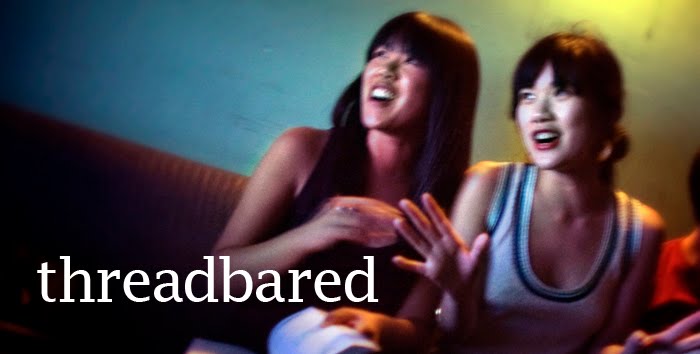 "Clothes are more than a little fraught for me," writes Krista Benson in the preface to a post that addresses some provocative, pertinent absences in fashionable discourses in new media (or what might cringingly be called the blogosphere). Bringing up two of the most troubling problems for the study of style as "self-expression," so often understood as a substantive good in and of itself, Benson continues:
"Clothes are more than a little fraught for me," writes Krista Benson in the preface to a post that addresses some provocative, pertinent absences in fashionable discourses in new media (or what might cringingly be called the blogosphere). Bringing up two of the most troubling problems for the study of style as "self-expression," so often understood as a substantive good in and of itself, Benson continues:They always have been. Unlike my academic-fashionista kin, I have not always loved clothes. I wasn't someone who was really clever with pairings or daring with how I dressed. I just ... wore clothes. The history of my discomfort with fashion is bifold and it's the oldest queer girl story in the book (or one of them, at least); it's about gender presentation and body dysmorphia.Her post points suggestively to a link between deviant bodies and sexual and gender anxieties that goes for the most part unremarked in fashion and style blogs, with some notable exceptions. (Fatshionista and lipstickeater, for instance, and some of the blogs I will be linking and excerpting in this series.) She notes that she often doesn't understand how clothes are supposed to fit her body --let alone clothes for professional purposes-- and explains further the trouble that gender makes:
Which leads to the second point of discomfort. As much as I love the aforementioned blogs, they're all variations upon femininity and femme-ness. Which is great, but it's not necessarily me. Occasionally, sure, I'm interested in some kind of queered femininity, often pairing something softer with some kick-ass boots or something, but in an average day, I'm not comfortable being that girly. I'm not masculine-presenting, exactly, but I am uncomfortable with compulsory femininity and, in a lot of ways, I'm not feminine.It is absolutely true that most fashion blogs --including those blogs dedicated to "professionals/academics," and this one at times-- tend to paint a rosy portrait of a happy relation to clothes. And this bothers me too, because there are so many times I hate this thing Fashion for its complicities, both mundane and avant-garde, with colonial racial classifications, predatory capital, class stratification and class slumming, able-bodiedness and rehabilitation imperatives, gender and sexual norms, biopolitical measures of health and beauty, militarism and imperial statecraft. (And as many times that I wish I could roll out everyday in my old punk rock uniform, which is partially nostalgia for sure.) And because I am also an "out, queer woman who is partnered with a woman," and whose gender presentation does appear to be femme --however unresolved I may be with such a designation, especially since this presentation was a conscious, and certainly troublingly expedient, decision I made to "professionalize"-- I want to echo Benson in the spirit of her questions.
This is, of course, complicated by being an out, queer woman who is partnered with a woman. Even in the notoriously liberal higher education field, assumptions are laid upon both of us in terms of presentation and expectations.
So I wanted to start this series of scattered thoughts and excerpted selections on "queer feelings, gender presentations" with Krista Benson and her provocative musings on the problems of deviant bodies and gender and sexual anxieties. Especially because of the increasingly pervasive cultural authority of fashion and style bloggers --on both individual and industrial registers-- it's critical that ideological categories as well as corporeal configurations of race, gender, sexuality, et cetera, are subject to ongoing contestation at these sites. What other sartorial experiments and experiences demonstrate to us that such categories and configurations are not simple, singular, or self-evident? For whom is "self-expression" through clothes or style difficult, unavailable, or even undesirable? What other gender presentations, sexual identities, and embodied states can point us suggestively toward alternative ways of inhabiting our clothes and the uncertain stories they tell?
(Image from Queer Action Figures, 1994)



